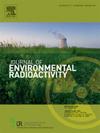Applied experimental research on in-situ online monitoring instrument for soil radon in fault zone
IF 1.9
3区 环境科学与生态学
Q3 ENVIRONMENTAL SCIENCES
引用次数: 0
Abstract
As an emerging method for seismic precursory signals in underground fluid, the reliability and stability of in-situ online monitoring devices for soil radon are crucial performance indicators that are directly related to the successful implementation of continuous monitoring of soil radon in seismic areas. This study conducted laboratory testing and field applications of a new in-situ online monitoring instrument for seismic soil radon, utilizing the experimental testing conditions provided by the radon monitoring instrument detection platform of the China Earthquake Administration and the natural experimental site at Xianshuihe Fault Zone in the China Seismic Experimental Site. The results indicate that laboratory measurement repeatability of the instrument is 5.53%, the relative intrinsic error of radon volume response activity is 1.53%, and the response capability of hourly sampling at high radon volume response activity (greater than 1.0 × 105 Bq/m3) lags behind the standard instrument by 2 h, essentially meeting the requirements for seismic observation. Under field conditions, the instruments exhibit good synchronization in response at different depths at the same location. However, further improvements are needed to enhance the consistency of long-term operation in the field, as well as the adaptability to outdoor self-powering, data transmission, and environmental conditions.
断层带土壤氡原位在线监测仪器的应用试验研究
作为地下流体地震前兆信号的一种新兴方法,土壤氡原位在线监测装置的可靠性和稳定性是至关重要的性能指标,直接关系到地震区土壤氡连续监测工作的顺利开展。本研究利用中国地震局氡监测仪器检测平台提供的实验测试条件和中国地震实验场咸水河断裂带自然实验场地,对新型地震土壤氡原位在线监测仪器进行了实验室测试和现场应用。结果表明,仪器的实验室测量重复性为 5.53%,氡体积响应活度的相对本征误差为 1.53%,在高氡体积响应活度(大于 1.0×105 Bq/m3)下每小时采样的响应能力落后标准仪器 2 h,基本满足地震观测的要求。在现场条件下,仪器在同一地点不同深度的响应表现出良好的同步性。不过,还需要进一步改进,以提高野外长期运行的一致性,以及对室外自供电、数据传输和环境条件的适应性。
本文章由计算机程序翻译,如有差异,请以英文原文为准。
求助全文
约1分钟内获得全文
求助全文
来源期刊

Journal of environmental radioactivity
环境科学-环境科学
CiteScore
4.70
自引率
13.00%
发文量
209
审稿时长
73 days
期刊介绍:
The Journal of Environmental Radioactivity provides a coherent international forum for publication of original research or review papers on any aspect of the occurrence of radioactivity in natural systems.
Relevant subject areas range from applications of environmental radionuclides as mechanistic or timescale tracers of natural processes to assessments of the radioecological or radiological effects of ambient radioactivity. Papers deal with naturally occurring nuclides or with those created and released by man through nuclear weapons manufacture and testing, energy production, fuel-cycle technology, etc. Reports on radioactivity in the oceans, sediments, rivers, lakes, groundwaters, soils, atmosphere and all divisions of the biosphere are welcomed, but these should not simply be of a monitoring nature unless the data are particularly innovative.
 求助内容:
求助内容: 应助结果提醒方式:
应助结果提醒方式:


